Japan
Wood Products Prices
Dollar Exchange Rates of 25th
June
2019
Japan Yen 107.18
Reports From Japan
¡¡
Business confidence deteriorating
A June 2019 survey to assess business sentiment
conducted by the Asahi Shimbun has shown that showing
Japanese business confidence is deteriorating rapidly.
Behind the falling confidence, said respondents, was
uncertain prospects in overseas economies and stagnation
of Japanese consumer spending. The survey of 100 major
Japanese companies has been conducted in the Spring and
Autumn annually for several years.
In the Spring 2019 survey only 32% of firms said business
conditions are expanding gradually, a sharp drop from the
66% of firms reporting expansion in the 2018 Autumn
survey. The number of companies saying business
conditions are weakening jumped to 10% in the Spring
2019 survey from around 1% in the 2018 Autumn survey.
http://www.asahi.com/ajw/articles/AJ201906180049.html
In related news, the Reuters poll has reported that
manufacturers¡¯ business confidence dropped to a 2½-year
low in June. Subdued business confidence, along with
slowing exports and domestic spending, has clouded the
outlook for the Japanese economy.
Will the Japanese pension be enough?
In mid-June, Japan¡¯s Financial Services Agency published
a report on the financial security of future retirees
suggesting that they would be wise to save more to make
up for expected shortfalls in the public pension system.
This sparked a major controversy in the government and
was immediately reported as likely to have a very negative
impact on consumer confidence and spending, core drivers
of the economy.
The report said, in the worst case, people should aim to
have yen 20 million savings to top up the ¡®average¡¯
pension for a retired couple in their 60s. The report
shocked many of the younger generation, few of whom
could ever save so much given the employment situation
in the country. Analysts are anticipating a further drop in
the consumer confidence index for June.
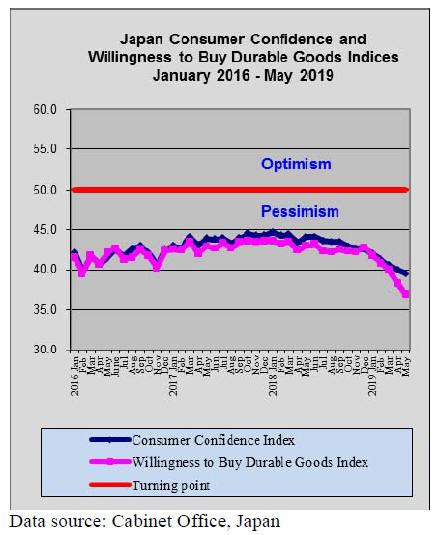
US dollar at new low against the yen
The US dollar weakened further in the second week of
June in anticipation of a July cut in interest rates by the US
Federal Reserve.
In June the yen fell to a low of 107 against the US dollar
on ¡®safe-haven¡¯ yen purchases as the Iran/US war of words
escalated however, the yen firmed after Japanese
government officials expressed concerns on recent yen
strength. It is widely anticipated that the Bank of Japan
(BoJ) would move quickly to stem any sharp rise in the
strength of the yen against the US dollar.
At the latest BoJ monetary policy meeting it was decided
to hold rates steady but Governor Kuroda made it clear
that the Bank is ready to add more stimulus if the risks to
the Japanese economy rise.
Kuroda said the Bank could combine interest rate cuts
with further asset buying if needed to keep the economy
on track to achieve its inflation target.
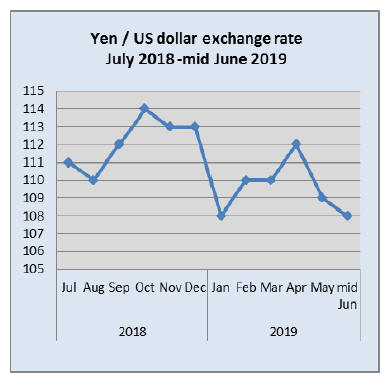
Second year on year decline in housing
starts
Japan¡¯s housing starts declined year on year for the second
month in May dropping by around 7%, worse than the 5%
drop in April. On an annual basis housing starts would
come in at 900,000 based on data up to May. The forecast
for 2019 starts was 948,000 down from the 988,000 in
2018.
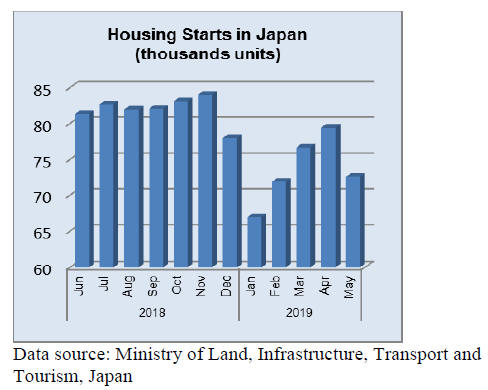 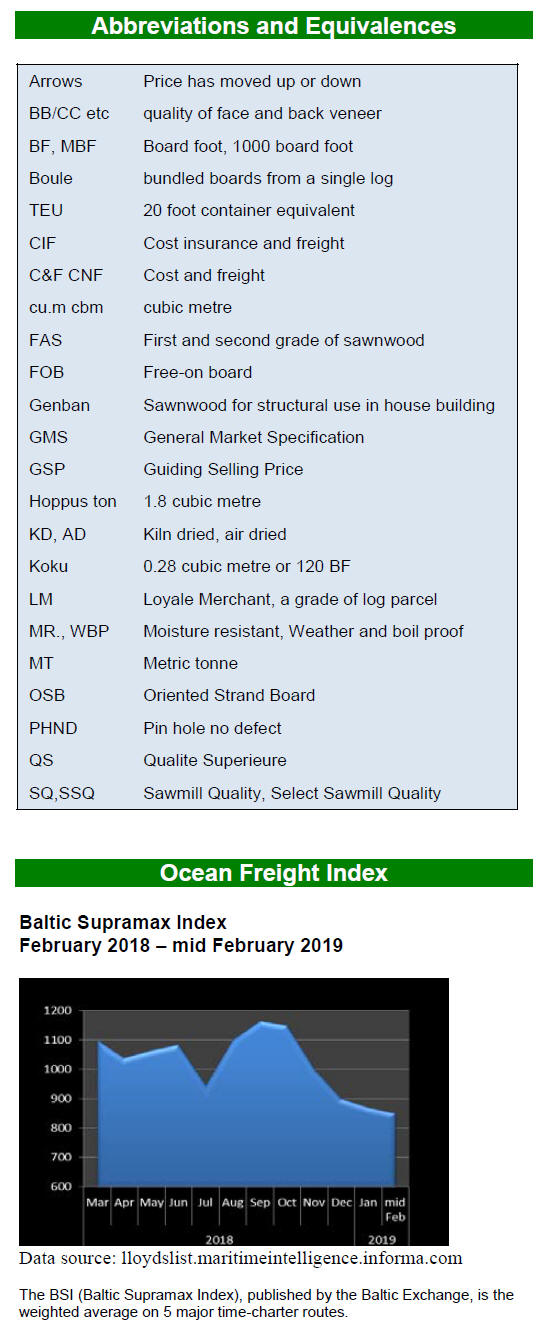
Office furniture imports (HS 940330)
Japanese importers of wooden office furniture tap into a
more diverse supply network than observed with imports
of either wooden kitchen or bedroom furniture.
March imports were mainly from China (49%) and
Germany which contributed a further 27%. If shipments
from Poland were added then over 80% of March imports
were from just these three countries.
A look at April wooden office furniture import sources
reveals a different picture as shippers in Poland, Italy and
Denmark took a good share of imports but were well
behind the 72% supplied from manufacturers in China.
Year on year, the value of April imports of wooden office
furniture fell 25% and there was a sharp 33% drop in
month on month imports. The value of April shipments
from China were at about the same level as in March,
shipments from Poland dropped 40% compared to March
but Italy surged back with an almost 70% rise in the value
of shipments compared to March.
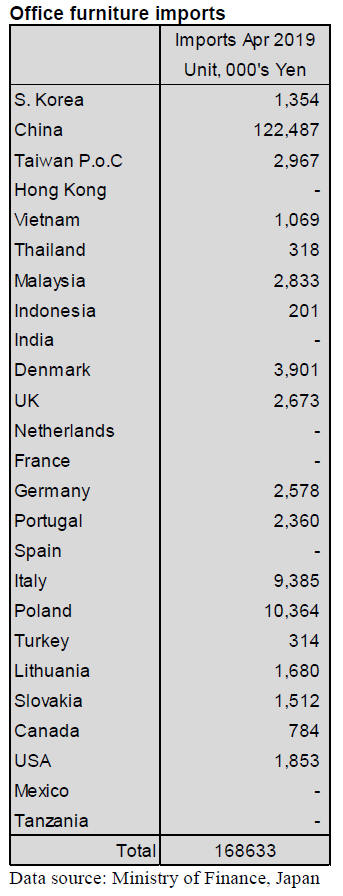
Kitchen furniture imports (HS 940340)
As has been the case for the past 12 months, the top
shippers of wooden kitchen furniture to Japan in April
were the Philippines (46% of all wooden kitchen furniture
imports) and Vietnam (40%). China is the third largest
shipper of wooden kitchen furniture to Japan and
contributed around 9% to the total value of imports in
April.
Year on year the value of April imports of wooden kitchen
furniture rose 21% but there was a 3% decline compared
to levels in March. April shipments from the Philippines
fell 10% month on month but Vietnam and China both
saw shipments rise in April (12% and 34% respectively).
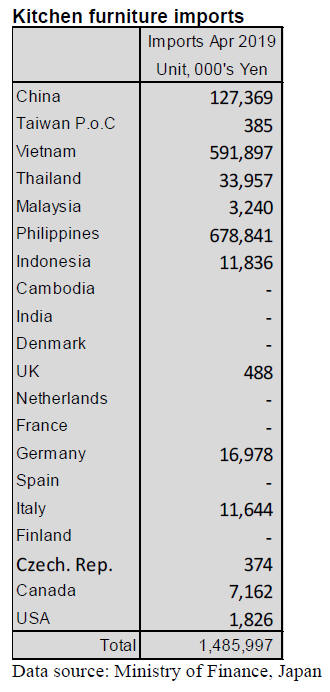
Bedroom furniture imports (HS 940350)
The decline in Japan¡¯s imports of wooden bedroom
furniture first noted in February continued into March but
April imports reversed the decline push the value of
imports the highest for 2019.
As in previous months, the combined value of imports of
wooden bedroom furniture from the top two shippers,
China and Vietnam, accounted for 90% of the value of
April 2019 imports. The third largest shipper was
Thailand, followed by Malaysia but their combined
imports only accounted for about 5% of all April imports.
Year on year the value of April imports of wooden
bedroom furniture was up 24% and there was a 27% rise
in the value of imports compared to March. The big
winners in April were China (39% rise m.o.m) and
Vietnam (21% rise m.o.m.). Thailand and Malaysia saw a
fall in shipments to Japan.
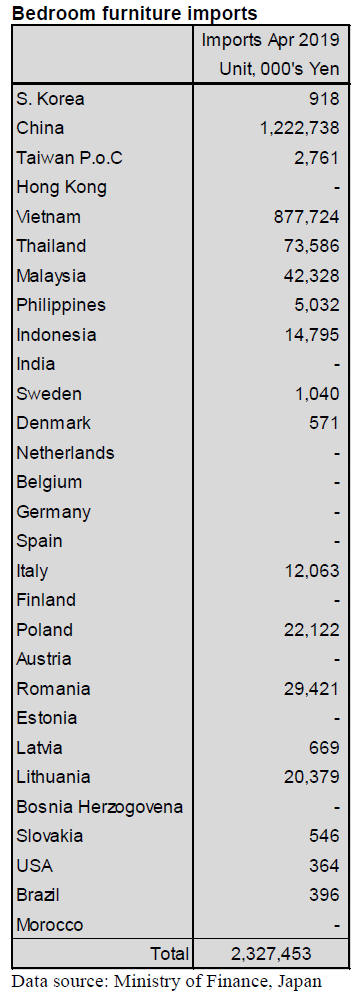
Trade news from the Japan Lumber Reports
(JLR)
The Japan Lumber Reports (JLR), a subscription trade
journal published every two weeks in English, is
generously allowing the ITTO Tropical Timber Market
Report to reproduce news on the Japanese market
precisely as it appears in the JLR.
For the JLR report please see:
http://www.n-mokuzai.com/modules/general/index.php?id=7
Agonizing South Sea (tropical) plywood manufacturers
Plywood manufacturers in Malaysia and Indonesia are in
tough spot with declining orders from overseas markets
and spiraling cost of logs.
Since spring of 2017, plywood prices in Malaysia and
Indonesia soared to record high level by log shortage
while the market in Japan continued sluggish log supply in
Indonesia started recovering gradually since fall of 2018
and plywood export prices weakened but the demand in
other markets like Korea dropped by trade conflict
between China and the U.S.A.
Some plants in Indonesia restarted manufacturing concrete
forming panels for Japan since last February and March
after the supply of concrete forming panels from Malaysia
in last two years decreased by log shortage in Sarawak.
Malaysian plywood manufacturers continued bullish
despite softening trend of Indonesia plywood prices but in
last two to three months, export prices of some items are
adjusted downward after log prices weakened after the
rainy season was over. Log prices of about 850 ringgit per
ton for last two years are now down to about 750 ringgit.
Production of plywood mills dropped by lack of orders so
mills profitability has not improved despite lower log cost.
Mills continue asking to reduce log prices to log suppliers
but log production cost remains high so further reduction
is unlikely.
Mills accept low priced orders from the Middle East
market to maintain production but low operation
continues.
Logs, plywood and palm oil are three major items for
wood industry in Sarawak, Malaysia but export of logs
and palm oil continues slow. Market of palm oil is soft
worldwide and log export shifted to PNG.
Import plywood market in Tokyo continues weak and
warehouses in Tokyo Bay ports are plugged with plywood.
Increasing container cargoes results in congestion as unstuffing
takes longer. This also influences unloading
works of bulk carriers.
Shipping companies bear demurrage and they are reluctant
to carry plywood now. They are collecting surcharge from
plywood manufacturers as they sell C&F base. Japanese
importers face difficult decision to purchase future
cargoes since it takes more time from placing orders to
delivery to the customers by port congestion.
Plywood
Movement of both domestic and imported plywood is
stagnant while the manufacturers¡¯ stance has no change.
Domestic manufacturers are now determined to correct
sales prices to their initial proposed prices because there
are variety of prices with precutting plants, which deal
direct with manufacturers.
South Sea hardwood plywood manufacturers show no sign
of reducing export prices so there is a gap between
suppliers¡¯ prices and market prices in Japan.
Demand of softwood plywood is getting active by orders
from precutting plants and trading firms¡¯ sales continue
busy so overall circumstances are favorable but due to
shortage of truck drivers and construction workers,
deliveries are delayed and construction works are delayed
so boom feeling is not really there. Also, market prices are
confused with some dumping sales.
Actually dealers are holding back new purchase as the
prices may weaken after new plywood mill started
running.
Softwood plywood manufacturing cost has been climbing
recently by higher log prices and transportation
prices so it is urgent issue for the manufacturers to bring
the sales prices up to cover higher cost.
The inventories by the manufacturers are not high and
some mills in Western Japan ran extra three days during
early May holidays to accumulate the inventory. April
production and shipment are almost even so that May
inventories should drop again.
Movement of imported hardwood plywood continues dull
even after lengthy holidays in early May. Dealers tried to
reduce the inventories after warehouse companies
increased storage charges so the market prices continue to
be weak. Thus, price hike is difficult when low priced
offers are in the market.
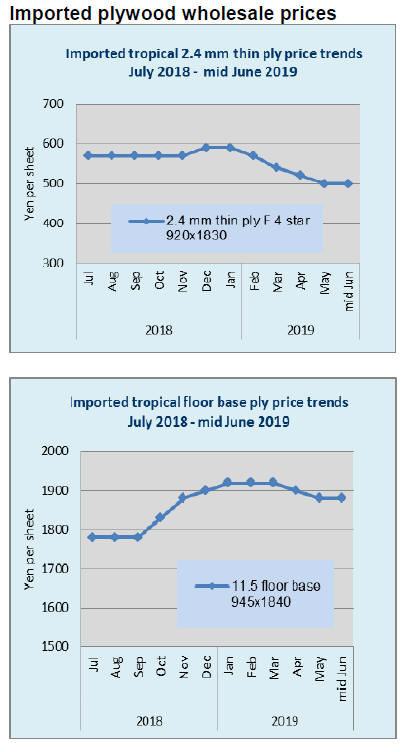 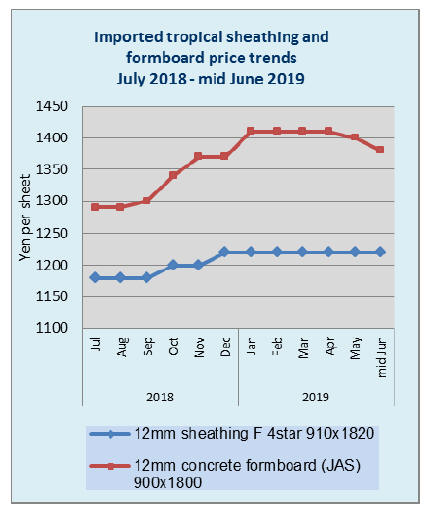
Performance of major house builders
Total housing starts in 2018 are 952,936 units, 0.7% more
than 2017. Owner occupied units are 287,710, 2.0% more.
Rental units are 390,093, 4.9% less. Units built for sale are
267,175, 7.5% more out of which condominiums are
119,683, 10.5% more and detached units are 144,905,
5.1% more.
Performance of major house builders in 2018 was almost
flat with 2017. Units built were almost same as 2017.
Business of no-residential units by major builders was
good. Orders of detached units are recovering but rental
unit boom was over and financial institutes tighten loans
for rental units as they are obviously over built and land
owners¡¯ mind is shrinking to build apartments.
Actually rental units start has been dropping month after
month for last two years. Meantime demand for detached
units built for sale continues active but the demand is
saturated so the largest builder feels alarming signal.
Since around 2015, rental unit building accelerated so that
not only rental units builders but other major house
builders had increasing orders. Compared to single
detached houses, apartment sales are larger and more
efficient to increase sales so house build ers shifted more
sales workers from detached unit to apartment and came
up with new apartment models to cover slow sales of
detached units.
Now after the boom of rental unit sales was over, house
builders need to find other means to cover drop of rental
unit sales so tide reversed from rental units to detached
units sales.
Fortunately rush-in demand before consumption tax
increase in October turned up so major house builders
shifted sales force from rental units to detached owner
occupied units and also put more effort to develop nonresidential
building sales.
Sumitomo Forestry and Misawa Homes, which specialize
detached owner occupied units, moved sooner to recover
orders and targets are younger first time buyers of urban
dwellers. Number of two income family increase and
buyers of major house builders increased.
Rental unit builders like Leo Palace 21 registered large
loss after many cases of corner-cutting construction was
found in their concrete condos and major executives
resigned. The largest rental units builder, Daito Trust
suffers declining orders.
Domestic logs and lumber
Log production through early June was steady so that log
supply is a bit too much and the log prices are on weak
side. Now that rainy season arrived, log production should
slow down and the forecast says this year¡¯s rainy
season is long so the log market should tighten in July.
Weak log market has been lasting for last four months. In
particular, down trend of cypress is conspicuous in last
two months. 4 meter sill cutting cypress log prices are
down to 16,500-17,000 yen in early June from over 20,000
yen up until last December and some low prices of less
than 16,000 yen are seen in some areas.
3 meter post cutting cedar log prices are held at 12,000-
13,000 yen in major supply areas but there are low offers
like 10,000 yen so the future is uncertain. 4 meter purlin
cutting cedar log prices are about 10,000 yen.
Lumber movement is steady mainly for large precutting
plants and the prices of KD 3 meter 105 mm cedar post are
50,000-52,000 yen and of KD 4 meter 105 mm cypress sill
are 64,000-65,000 yen. Lumber buyers demand further
reduction because log prices are down but lumber prices
have not gone down as much as logs.
Compared to 105 mm lumber, 120 mm lumber market is
weak with slow demand on both green and KD lumber.
Prices of low priced common cedar lumber shot up to
32,000 yen since last summer through early this year by
supply shortage are now back down to30,000 yen as the
demand is simmering down.
New plywood mill completed
Ohita plant of Shin-ei Plywood, one of Seihoku group
companies, completed building plywood manufacturing
plant. The plant uses 100% domestic species to
manufacture structural softwood plywood.
The annual production is 68,000 cbms (monthly
production of 280,000 sheet of 12 mm 3x6) It uses
cypress for face and back with cedar core but it also plans
to make 100% cedar panel. The market is Northern
Kyushu. This is the second plant for Shin-ei.
Annual log consumption would be about 110,000 cbms
(70% cedar and 30% cypress). Shin-ei is the only plywood
mill in Kyushu with the first plant in Minamata, which
produces softwood structural plywood and coated concrete
forming panel.
Annual log consumption of this plant is 300,000 cbms out
of which 270-280,000 cbms are domestic species plus
some imported logs but in two to three months, all the logs
it uses will be domestic species. It uses logs from three
neighboring prefectures of Kumamoto, Kagoshima and
Miyazaki.
By completion of Ohita plant, log procurement is more
stable by dividing territories and Minamata plant will
produce more coated concrete forming panel after Ohita
plant produces enough structural panels. Sin-ei
experienced hard time to satisfy customer¡¯ orders after
Kumamoto earthquake when demand for structural panels
increased for restoration of damaged areas and it felt
necessity to have another plant in Kyushu.
|